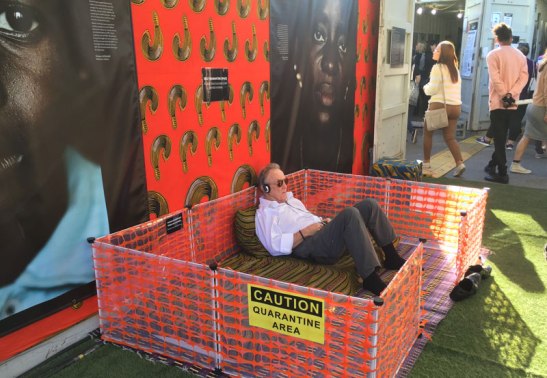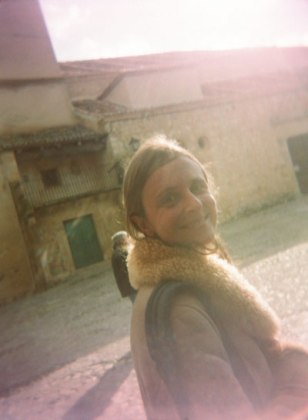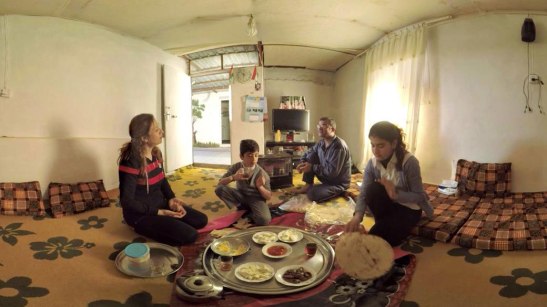Photointeractivity at Photoville
The weather gods were smiling on Photoville this year, bringing sun and gentle breezes to the festival’s fifth anniversary. In fact, in my memory, this mellow photo festival in shipping containers on the Brooklyn waterfront has had mostly good weather every year (with the exception of a brief thunderstorm on the first day of Year One ). That’s pretty lucky considering that now, just a week later, we’re having a damp and gloomy long weekend.
There were some changes this year: the festival was located more centrally in the Brooklyn Bridge Plaza, right under the iconic bridge, which gave less space for the shipping container exhibits—a move that was offset by having two levels of containers in some places. And there was a much larger beer and food garden, on an actual lawn, which allowed for more relaxed picnicking, socializing and nighttime programming.
What struck me most about this year’s festival, though, was the element of interactivity that formed a part of many of the exhibits. Photoville has always been about engagement: the choice of humble shipping containers allows exhibitors to take risks and viewers to experience art in new ways. But this year, exhibitors were getting viewers to interact in novel, creative ways with the imagery on show. This led me to coin what, according to a brief Internet search, seems to be a new term: photointeractivity. It’s a direction many photo-artists and outlets are going in, and on balance I think it’s a good thing.
Take, for example, the Doctors Without Borders container, Forced from Home , in which viewers could don virtual reality headsets and experience one of three stories about displaced people. According to one of the guides I spoke to, these short VR documentaries were captured by a wheeled rig fitted with five GoPro cameras, whose footage was stitched together to create a panoramic video. I watched the story of a Syrian family in a refugee camp in Iraq, and it was truly amazing: experiencing the panoramic video was like plunging through a screen right into the environment. In fact, it was so visceral that it was jarring to remove the headset afterward and be jolted back to hipster, artisanal Brooklyn.
In the container of another nonprofit organization, the Open Society Foundations , there was a less high-tech but striking ‘Quarantine Area’ where visitors could sit and listen to radio recordings from West Africa while looking at portraits of Ebola victims from the region. The container was decorated with West African textiles, adding an element of local color that contrasted with the bleak stories on display.

A viewer listens to radio broadcasts from West Africa in the Open Society’s Ebola Through the Lens . Image (c) Sarah Coleman
But perhaps the ultimate in documentary photointeractivity was in the container for LiveZEKE , a presentation of ZEKE magazine , the child of the excellent website SocialDocumentary.net . Both SocialDocumentary.net and ZEKE focus on hard-hitting social documentary photography, and LiveZEKE matched festivalgoers, via live video conferencing, with subjects from a documentary series called ‘The Forgotten Caucasus.’
“As a documentary photographer, I always wished that the viewer of the photograph could have a similar experience as I was having while taking the photo—to communicate directly with the subject,” said Glenn Ruga, ZEKE ’s editor, of a creative interaction which, to his knowledge, has not been attempted before. Ruga said he’d wanted to “push the envelope, in light of the fact that ZEKE magazine is a vey retro idea—a print magazine.” One of his aims was to make the viewing experience more “visceral” and “meaningful” for the viewer. “I think the original photo and exhibition is important to provide the concept and context. But then the LiveZEKE brings a human interaction that can be the strongest lasting connection.”
That was certainly the case for one viewer, a singer who ended up performing a jazz scat with photo subject and pianist Edik Aghajanyan, who was 6,000 miles away on the other side of the video link. The impromptu performance, which had the effect of erasing the distance between the two musicians, charmed the crowd. “There’s often a big separation between the community that gets photographed and the community that then gets to see the pictures,” said festivalgoer Emily Pederson. “To actually have their presence there, in the exhibit, is pretty extraordinary…and powerful.”
Nearby, another project offered viewers a different way to get involved: by contributing images. Recently, veteran documentary photographer Ron Haviv collaborated with publisher Blurb to process hundreds of rolls of undeveloped film that were lying around his studio. After decades of neglect, the films were variously faded, fogged and chafed, their emulsions subject to heat and mold and time. This gave them a mysterious, often delicate quality, a “distressed” look that, ironically, contemporary photographers sometimes add in post-production. Haviv’s book The Lost Rolls , which features some of his rediscovered images from decades of work as a conflict photographer, is the result.

Ron Haviv’s rediscovered snapshot of his late friend, photojournalist Alexandra Boulat, inspired The Lost Rolls and Lost Rolls America . Image (c) Ron Haviv
All of this is jump-starting a project called Lost Rolls America , to which the general public is invited to send old, undeveloped rolls of film. Fujifilm will develop the film and upload the images to a secure server, from which the photographer will choose one image and write a memory around it. This will culminate with a book and exhibition in 2017.
Why delve into film that was apparently not important enough to develop at the time? In a discussion called Memory in the Time of Disposable Imagery , Haviv and cultural historian Lauren Walsh hashed out some of the reasons. This is a way of “democratizing history” (opening it up to diverse voices and experiences), said Walsh, and creating a sort of national family album of significant, rediscovered images. Which is all the more important, she said, since many of her young students view photographs as disposable and albums as a quaint relic of their dinosaur parents.
On a somewhat lighter note, Sophie Gamand ’s container Flower Power sought to change the image of pitbulls, which are often euthanized because of their reputation for violence. Drawing on Baroque painting, Gamand photographed a variety of shelter pitbulls in floral garlands, highlighting their dignity and gentleness. In an associated program, some of the up-for-adoption dogs from the series made appearances at the festival. Though none was adopted, says Gamand (“these things take time,”) they at least introduced themselves to a host of potential owners.
How the camera sees, what the photographer’s intention is, who’s viewing the result: these issues have been with us since the dawn of photography. On the other hand, photointeractivity—of the digital kind, at least—is relatively new. If I’m right, and it is indeed a trend, a possible downside might be that it puts photographers under pressure to bring a ‘Wow’ factor to their work by adding an immersive element. But the payoffs are huge. In the 1910s, Lewis Hine revolutionalized the cause of child labor by adding dramatic visuals (in the form of photographs of underage workers) to the National Child Labor Committee’s written reports. Photointeractivity strikes me as the next step in this continuum—a new way of dissolving boundaries, attracting attention, encouraging empathy. And that’s got to be a good thing.







